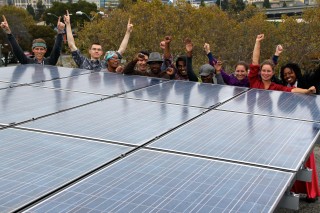Three years ago, the prospects for Americans to own their energy future seemed relatively bleak. There were almost no replicable models for doing community-based energy projects or investment, despite falling costs and technology – solar and wind – that lend themselves to local development.
But thanks to recent opportunities in community solar and crowdfunding, we may see a renewable energy market in America where everyone wins.
Let’s start with solar. It’s the ultimate decentralized renewable energy – sunshine falls everywhere – and its cost is falling so fast that, within a decade, 300 gigawatts of unsubsidized solar will be competitive with local electricity prices in communities across the country. In 2010, just one model for developing community solar had proved readily replicable and there was no practical way to pool a community’s collective capital to invest in local energy (except perhaps a municipal utility, a story for another time). Since nearly three-quarters of residential rooftops are not suitable for solar, it was hard to see how most Americans could use the sun to brighten their energy future.
But in 2013, community solar is rising fast. Colorado’s community solar gardens program – selling out its 9 megawatt limit in a half hour – illustrates a powerful model for letting people pool their money to go solar, even if their own roof isn’t theirs or isn’t sunny. Some companies in Colorado have already brought their model to other states, like the Clean Energy Collective‘s community solar project with the Wright-Hennepin Electric Cooperative in Minnesota, and other states (like Minnesota) are considering legislation to expand the opportunity.
The year 2013 may also be remembered for opening the crowdfunding floodgates.
In late 2012, California-based (Solar) Mosaic launched their first community solar investment project, allowing 51 California investors earn 6.38% returns for investing in a 47 kilowatt (kW) solar array on the roof of the Youth Employment Partnership in Oakland. Their subsequent 235 kW project ups the ante, and was open to regular folks in California and New York (and accredited investors in all 50 states). It sold out in just 24 hours to over 400 investors with an average stake of just $700. The investment uses a common securities law exemption (Rule 506 of Regulation D), and investors will earn a 4.5% annual return (net of fees) over 9 years, greening the economy and their pocketbooks.
The key advantage of Solar Mosaic is the investment. Previous community solar projects have relied on shared electricity savings for participants, sometimes called virtual net metering. This limits prospective investors to the same utility service territory, and the savings can’t be taken to a property outside that area. The Mosaic model turns community solar into a simple investment, letting prospective investors select a particular Mosaic project to invest in, with significantly higher returns than parking money in a U.S. Treasury or savings account. For now, it’s limited to broad participation in just two states, New York and California, but Mosaic is “working hard” to expand the opportunity.
Mosaic may be just the first salvo in a firestorm of community renewable energy investment. The federal JOBS Act of 2012 intends to create a new segment of investment security with much lower upfront and legal costs that would let crowds pool up to $1 million for solar and other renewable energy projects.The only “drawback” in the Mosaic model is that it doesn’t explicitly connect geography with investment. A New York City resident, for example, can invest in a project in California, but not in Manhattan or the Bronx. If this model continues to be successful, however, it’s likely that will change.
Crowdfunding doesn’t have to be limited to renewable energy, either. People could pool their resources to invest in block-by-block residential energy efficiency retrofits, reducing their own and their neighbors’ energy bills and sharing the energy savings with other local investors. Crowdfunding for energy efficiency could be combined with commercial building energy ratings (just enacted in Minneapolis, MN, for example) to target the least efficient buildings with the most potential for savings. Local shared investment wouldn’t just tap and share more energy savings, but would boost the local economy by putting idled laborers to work making buildings more cost-effective and less climate harming.
Both community solar and crowdfunding are in their infancy, but they represent two powerful tools for Americans to take charge of their energy future.
Photo credit: Mosaic


